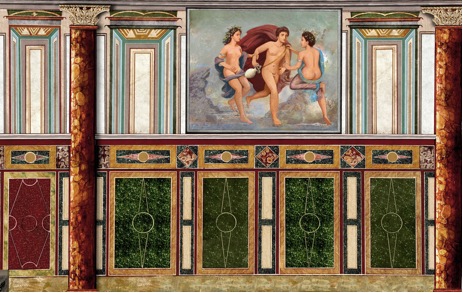Ancient period and the early history in northern France
Gallo-Roman fresco in Charleville-Mézières
Situated on the banks of the river Meuse, the Gallo-Roman town which is understood to have existed on the site of Montcy-Saint-Pierre, now a district of Charleville-Mézières, is gradually revealing its importance. It was there that, in November 1999, sanitation works in the town resulted in the uncovering of the ruins of a Gallo-Roman cellar. Pieces of painted plaster and fragments of stucco were discarded pell-mell. After piecing together the "jigsaw puzzle" from the ancient rubble, archeologists specialising in Roman painting reconstructed large panels of a mural that restorers then erected, enhanced, on a new mount.
In around 160-180 AD, plasterers, sculptors, decorators and painters created this painting "a fresco", i.e. painted directly on to fresh sand and lime mortar. Stretching to the very edges of the Empire, Roman subjects who lived far from Rome itself highlighted their loyalty and devotion to the Roman Empire throught the architecture and the themes they chose for the decoration of their homes. Here in the dressing rooms (apodyterium) or in the "warm room" (tepidarium) of the baths we can imagine the bathers having left the hot steam room (caldarium) and relaxing under a scene depicting the kidnapping of Hylas by the nymphs.


